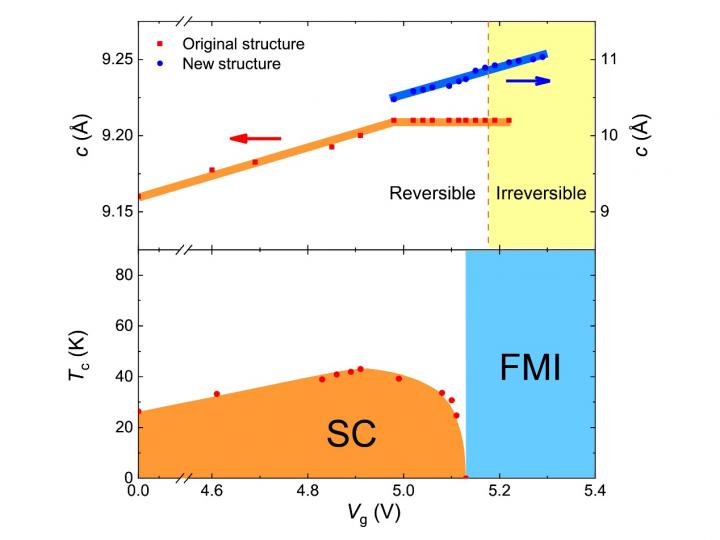
Credit: ©Science China Press
High-temperature (Tc) superconductivity typically develops from antiferromagnetic insulators, and superconductivity and ferromagnetism are always mutually exclusive. Recently, Xianhui Chen’s group at University of Science and Technology of China observed an electric-field controlled reversible transition from superconductor to ferromagnetic insulator in (Li,Fe)OHFeSe thin flake. This work offers a unique platform to study the relationship between superconductivity and ferromagnetism in Fe-based superconductors and may provide some clue about understanding the electron pairing mechanism beyond conventional electron-phonon superconductivity.
The relationship between superconductivity and magnetism is key to understanding the electron pairing mechanism beyond conventional electron-phonon superconductivity. Controlling the magnetism near the superconducting region could explain the competing or intertwined electronic states in superconducting and magnetic phases. Modulating carrier density via field electric transistors (FET) is one of the most effective ways to manipulating the collectively ordered electronic states in condensed matter physics. However, only the carrier concentration on the surface of materials can be tuned with conventional gating technique and controlling the charge density in the bulk is plagued due to the Thomas-Fermi screening. Recently, a new type of FET has been developed using solid ion conductor (SIC) as the gate dielectric. In such a SIC-FET, the electric field can not only tune the carrier density to induce electronic phase transitions, but also drive ions into a crystal to transform it from one crystalline phase to another.
By this new developed gating technique, Xianhui Chen’s group at University of Science and Technology of China observed an electric-field controlled reversible transition from superconductor to ferromagnetic insulator in (Li,Fe)OHFeSe thin flake. Using SIC-FET, Li ions can be driven into or extracted out from the (Li,Fe)OHFeSe thin flake by electric field. When the Li ions are initially driven into the thin flake, Li ions replace the Fe in the hydroxide layers and the Fe ions expelled by Li can migrate away from the hydroxide layers to fill the vacancies in the selenide layers. Once the vacancies are filled, the thin flake achieves the optimal Tc ~ 43 K. With further Li injection, the Fe ions extruded from the hydroxide layers migrate to the interstitial sites, and then the interstitial Fe ions become ordered and eventually lead to a long-range ferromagnetic order. So, a dome-shaped superconducting phase with optimal Tc (= 43 K) is continuously tuned into a ferromagnetic insulating phase, which exhibits an electric-field-controlled quantum critical behavior. The device is fabricated on a solid ion conductor, which can reversibly manipulate collectively ordered electronic states of the materials and stabilize new metastable structures by electric field. This work paves a way to access metastable phases and to control structural phase transformation as well as physical properties by the electric field.
These surprising findings offer a unique platform to study the relationship between superconductivity and ferromagnetism in Fe-based superconductors. This work also demonstrates the superior performance of SIC-FET in regulating the physical properties of layered crystals and its potential applications for multifunctional devices.
###
This work is supported by the National Key R & D Program of China (Grant Nos.2017YFA0303001 and 2016YFA0300201), the Strategic Priority Research Program (B) of the Chinese Academy of Sciences (Grant No.XDB25010100), the National Natural Science Foundation of China (Grant No. 11888101, 11534010), Science Challenge Project (Grants No. TZ2016004) and Hefei Science Center CAS (2016HSC-IU001).
See the article:
Likuan Ma, Bin Lei, Naizhou Wang, Kaishuai Yang, Dayong Liu, Fanbao Meng, Chao Shang, Zeliang Sun, Jianhua Cui, Changsheng Zhu, Tao Wu, Zhe Sun, Liangjian Zou, Xianhui Chen. Electric-field controlled superconductor-ferromagnetic insulator transition. Science Bulletin, 2019, 64(10) 653-658.
https:/
Media Contact
X. H. Chen
[email protected]
Related Journal Article
http://dx.




